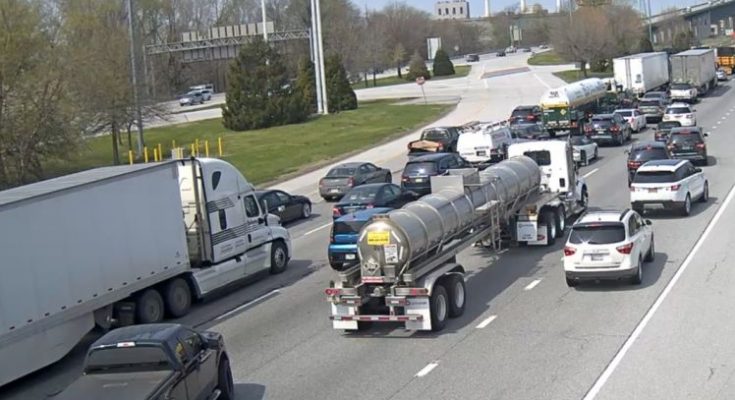Not since the summer of 2008 have motorists felt such pain at the pump, as gas prices continue their ascent that began two months ago. The average retail price of a gallon of regular, self-service gasoline in Delaware crossed the $4.00 threshold overnight for the first time since July 19, 2008. The Delaware gas average is up four cents overnight, up 40 cents in the past week, up 63 cents in the past month, and $1.39 higher than one year ago.
The national average retail price for a gallon of regular, self-service gasoline also topped $4.00 per gallon, a benchmark not seen since July 25, 2008.
“The effects of Russia invading Ukraine, coupled with tight worldwide oil supplies and increased demand, continue to impact the upward climb of crude oil and, in turn, gas prices,” said Jana Tidwell, spokesperson for AAA Mid-Atlantic. “Motorists are feeling the pain at the pump and we’re still months away from the start of the peak summer driving season. Although speculation can run awry, economic indicators continue to point to higher crude oil and gasoline prices for the remainder of winter and into spring.”
AAA Gas Prices – March 6, 2022
Average price per gallon of self-serve, regular gasoline
|
Today |
Yesterday |
Last Week |
Last Month |
Last Year |
|
|
National |
$4.00 |
$3.92 |
$3.60 |
$3.43 |
$2.76 |
|
Delaware |
$4.00 |
$3.96 |
$3.60 |
$3.37 |
$2.69 |
|
New Jersey |
$4.09 |
$3.98 |
$3.65 |
$3.49 |
$2.87 |
|
Pennsylvania |
$4.17 |
$4.08 |
$3.75 |
$3.61 |
$2.98 |
Gas prices provided by AAA, http://gasprices.aaa.com/
At the close of Friday’s formal trading session, WTI ended the week up 7.4% to settle at $115.68 per barrel. Earlier this week, the President announced a release from the Strategic Petroleum Reserve, however, did not include details of when this will happen. The pricing impact from this announcement has been limited since the amount of oil that may be released is small in comparison to the amount of oil that flows daily from Russia around the globe.
AAA Gas Saving Tips
Get your vehicle checked out. Perform regular car maintenance at the intervals recommended by the vehicle manufacturer in the owner’s manual or as indicated by the in-car maintenance reminder system. Did you delay regular maintenance during the pandemic because you were driving less? Now is the time to get it looked at. Find a AAA Approved Auto Repair Facility here.
Keep tires properly inflated. Under-inflated tires can decrease your gas mileage by approximately 3 percent. Not to mention, properly inflated tires are safer and last longer. Check pressure in all four tires every two weeks with an accurate, hand-held air pressure gauge.
Know your octane. Do not purchase mid-grade or premium gas unless your owner’s manual specifically recommends it. According to AAA research, Americans waste more than $2.1 billion annually on premium gas in vehicles designed to run on regular fuel. AAA found no benefit to using premium gas instead of regular-grade fuel. At the time of the study, 70% of U.S. drivers owned a vehicle that required only regular gasoline.
Avoid idling. Idling gets zero miles per gallon. Letting your vehicle idle for more than 10 seconds uses more gas than shutting it off and restarting. Don’t start your car until you are ready to go. The engine actually warms up more quickly once the car is operating, and will stay warm after stopping. Avoid drive-up windows – park and go inside instead.
Observe the speed limit. Gas mileage decreases rapidly at speeds above 60 mph. Each 5 mph you drive over 60 mph is like paying an additional $0.15 per gallon of gas. Using cruise control on the highway helps you maintain a constant speed and, in most cases, will save gas.
Drive sensibly. Aggressive driving (speeding, rapid acceleration and braking) wastes gas. It can lower your gas mileage by 33 percent at highway speeds and by 5 percent around town.
Consolidate trips. Combining errands into one trip saves you time and money. Several short trips taken from a cold start can use twice as much fuel as a longer multi-purpose trip covering the same distance when the engine is warm. With a little planning, you can avoid retracing your route and reduce the distance you travel as well. You’ll not only save fuel, but also reduce wear and tear on your car.
Minimize drag. Drag reduces fuel efficiency. Driving with the windows open, using roof- or rear-mounted racks and carrying heavy loads increase vehicle drag. A roof rack or carrier provides additional cargo space and may allow you to meet your needs in a smaller, more fuel efficient car. However, a loaded roof rack can decrease your fuel economy by 5 percent. Reduce aerodynamic drag and improve your fuel economy by using a removable rack and placing items inside the trunk whenever possible. Avoid carrying unnecessary items, especially heavy ones. An extra 100 pounds in the trunk reduces a typical car’s fuel economy by 1-2 percent.
Source: AAA





